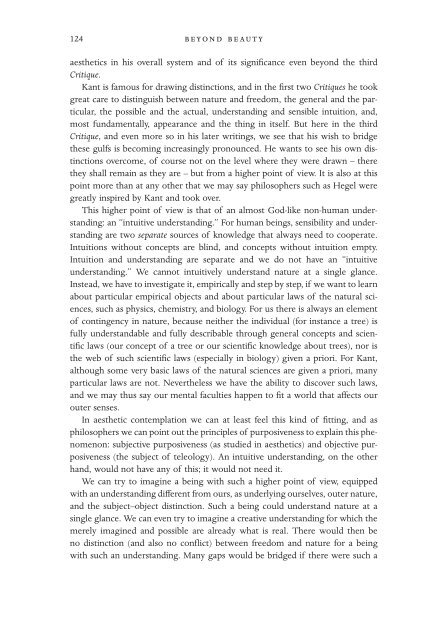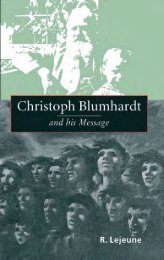AN INTRODUCTION TO KANT'S AESTHETICS
AN INTRODUCTION TO KANT'S AESTHETICS
AN INTRODUCTION TO KANT'S AESTHETICS
Create successful ePaper yourself
Turn your PDF publications into a flip-book with our unique Google optimized e-Paper software.
124 BEYOND BEAUTY<br />
aesthetics in his overall system and of its significance even beyond the third<br />
Critique.<br />
Kant is famous for drawing distinctions, and in the first two Critiques he took<br />
great care to distinguish between nature and freedom, the general and the particular,<br />
the possible and the actual, understanding and sensible intuition, and,<br />
most fundamentally, appearance and the thing in itself. But here in the third<br />
Critique, and even more so in his later writings, we see that his wish to bridge<br />
these gulfs is becoming increasingly pronounced. He wants to see his own distinctions<br />
overcome, of course not on the level where they were drawn – there<br />
they shall remain as they are – but from a higher point of view. It is also at this<br />
point more than at any other that we may say philosophers such as Hegel were<br />
greatly inspired by Kant and took over.<br />
This higher point of view is that of an almost God-like non-human understanding:<br />
an “intuitive understanding.” For human beings, sensibility and understanding<br />
are two separate sources of knowledge that always need to cooperate.<br />
Intuitions without concepts are blind, and concepts without intuition empty.<br />
Intuition and understanding are separate and we do not have an “intuitive<br />
understanding.” We cannot intuitively understand nature at a single glance.<br />
Instead, we have to investigate it, empirically and step by step, if we want to learn<br />
about particular empirical objects and about particular laws of the natural sciences,<br />
such as physics, chemistry, and biology. For us there is always an element<br />
of contingency in nature, because neither the individual (for instance a tree) is<br />
fully understandable and fully describable through general concepts and scientific<br />
laws (our concept of a tree or our scientific knowledge about trees), nor is<br />
the web of such scientific laws (especially in biology) given a priori. For Kant,<br />
although some very basic laws of the natural sciences are given a priori, many<br />
particular laws are not. Nevertheless we have the ability to discover such laws,<br />
and we may thus say our mental faculties happen to fit a world that affects our<br />
outer senses.<br />
In aesthetic contemplation we can at least feel this kind of fitting, and as<br />
philosophers we can point out the principles of purposiveness to explain this phenomenon:<br />
subjective purposiveness (as studied in aesthetics) and objective purposiveness<br />
(the subject of teleology). An intuitive understanding, on the other<br />
hand, would not have any of this; it would not need it.<br />
We can try to imagine a being with such a higher point of view, equipped<br />
with an understanding different from ours, as underlying ourselves, outer nature,<br />
and the subject–object distinction. Such a being could understand nature at a<br />
single glance. We can even try to imagine a creative understanding for which the<br />
merely imagined and possible are already what is real. There would then be<br />
no distinction (and also no conflict) between freedom and nature for a being<br />
with such an understanding. Many gaps would be bridged if there were such a



